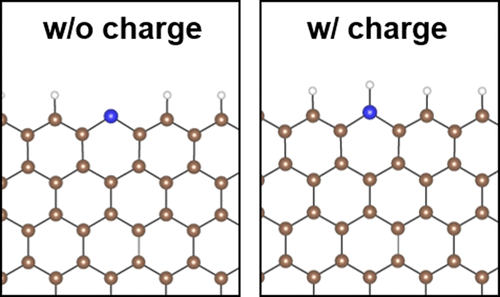当前位置:
X-MOL 学术
›
J. Am. Chem. Soc.
›
论文详情
Our official English website, www.x-mol.net, welcomes your feedback! (Note: you will need to create a separate account there.)
Substantial Impact of Charge on Electrochemical Reactions of Two-Dimensional Materials
Journal of the American Chemical Society ( IF 15.0 ) Pub Date : 2018-06-29 , DOI: 10.1021/jacs.8b03002 Donghoon Kim 1 , Jianjian Shi 1 , Yuanyue Liu 1
Journal of the American Chemical Society ( IF 15.0 ) Pub Date : 2018-06-29 , DOI: 10.1021/jacs.8b03002 Donghoon Kim 1 , Jianjian Shi 1 , Yuanyue Liu 1
Affiliation

|
Two-dimensional (2D) materials have attracted great interest in catalyzing electrochemical reactions such as water splitting, oxygen reduction, and carbon dioxide reduction. Quantum mechanical simulations have been extensively employed to study the catalytic mechanisms. These calculations typically assume that the catalyst is charge neutral for computational simplicity; however, in reality, the catalyst is usually charged to match its Fermi level with the applied electrode potential. These contradictions urge an evaluation of the charge effects. Here, using the example of hydrogen adsorption on the common 2D electrocatalysts (N-doped graphene and MoS2) and 3D metal catalysts, and employing the grand canonical density functional theory, we show that the charge on 2D materials can have a much stronger impact on the electrochemical reaction than the charge on 3D metals (the reaction energy can differ by >1 eV after including the charge effects). This arises from the charge-induced change in the occupation of electronic states, which is more significant for 2D materials due to their limited density of states. Our work provides a fundamental understanding of the charge effects in 2D materials, calls for re-evaluation of the previously suggested mechanisms by including the overlooked charge effects, and offers practical guidelines for designing 2D catalysts.
中文翻译:

电荷对二维材料电化学反应的实质性影响
二维 (2D) 材料在催化水分解、氧还原和二氧化碳还原等电化学反应方面引起了极大的兴趣。量子力学模拟已被广泛用于研究催化机制。为了计算简单,这些计算通常假设催化剂是电荷中性的;然而,实际上,催化剂通常被充电以使其费米能级与施加的电极电位相匹配。这些矛盾促使人们对电荷效应进行评估。在这里,以常见的 2D 电催化剂(N 掺杂石墨烯和 MoS2)和 3D 金属催化剂上的氢吸附为例,并采用正则密度泛函理论,我们表明,2D 材料上的电荷对电化学反应的影响比 3D 金属上的电荷要大得多(在包括电荷效应后,反应能量可以相差 >1 eV)。这是由电荷引起的电子态占据的变化引起的,这对于 2D 材料而言更为重要,因为它们的态密度有限。我们的工作提供了对二维材料中电荷效应的基本理解,呼吁通过包括被忽视的电荷效应来重新评估先前提出的机制,并为设计二维催化剂提供实用指南。由于状态密度有限,这对于 2D 材料更为重要。我们的工作提供了对二维材料中电荷效应的基本理解,呼吁通过包括被忽视的电荷效应来重新评估先前提出的机制,并为设计二维催化剂提供实用指南。由于状态密度有限,这对于 2D 材料更为重要。我们的工作提供了对二维材料中电荷效应的基本理解,呼吁通过包括被忽视的电荷效应来重新评估先前提出的机制,并为设计二维催化剂提供实用指南。
更新日期:2018-06-29
中文翻译:

电荷对二维材料电化学反应的实质性影响
二维 (2D) 材料在催化水分解、氧还原和二氧化碳还原等电化学反应方面引起了极大的兴趣。量子力学模拟已被广泛用于研究催化机制。为了计算简单,这些计算通常假设催化剂是电荷中性的;然而,实际上,催化剂通常被充电以使其费米能级与施加的电极电位相匹配。这些矛盾促使人们对电荷效应进行评估。在这里,以常见的 2D 电催化剂(N 掺杂石墨烯和 MoS2)和 3D 金属催化剂上的氢吸附为例,并采用正则密度泛函理论,我们表明,2D 材料上的电荷对电化学反应的影响比 3D 金属上的电荷要大得多(在包括电荷效应后,反应能量可以相差 >1 eV)。这是由电荷引起的电子态占据的变化引起的,这对于 2D 材料而言更为重要,因为它们的态密度有限。我们的工作提供了对二维材料中电荷效应的基本理解,呼吁通过包括被忽视的电荷效应来重新评估先前提出的机制,并为设计二维催化剂提供实用指南。由于状态密度有限,这对于 2D 材料更为重要。我们的工作提供了对二维材料中电荷效应的基本理解,呼吁通过包括被忽视的电荷效应来重新评估先前提出的机制,并为设计二维催化剂提供实用指南。由于状态密度有限,这对于 2D 材料更为重要。我们的工作提供了对二维材料中电荷效应的基本理解,呼吁通过包括被忽视的电荷效应来重新评估先前提出的机制,并为设计二维催化剂提供实用指南。


























 京公网安备 11010802027423号
京公网安备 11010802027423号